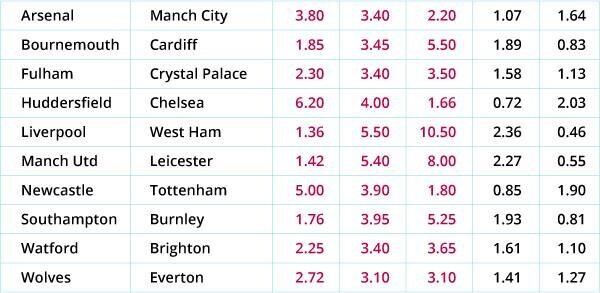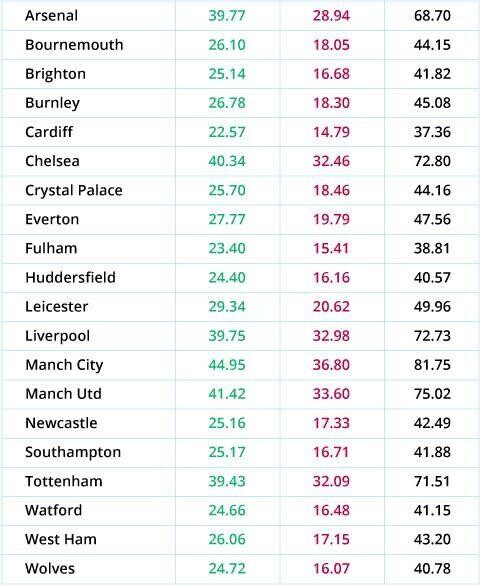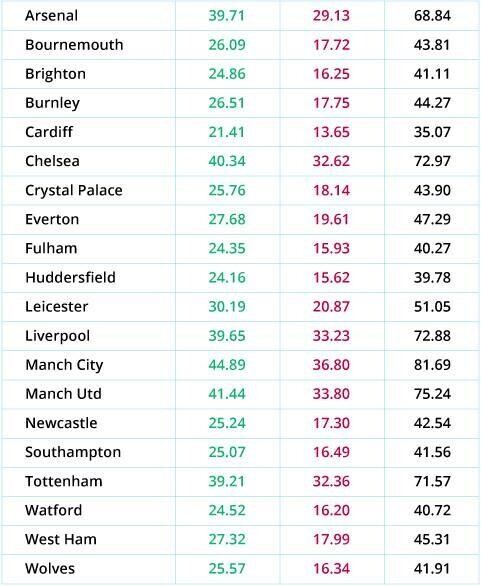
James Banting Tipster Competition Assistant
James has worked for the jockey club and has 20 years sports betting experience he utilises his skills in our tipster competitions and writes sports betting content.
I mention the Premier League but the same principles would apply to most leagues.

Once into August, most serious football pundits and punters will have assessed football form from previous seasons, noted any new signings, and framed their shortlist of teams that could:
-
Win the English Premier League.
-
Finish in the top 4 or 6.
-
Fighting a relegation battle.
That process can’t be finalised in June or July but some preparation must (even subconsciously) go into it long before coming to any conclusions.
How they go about it will vary from person to person otherwise everyone would come to the same answers.
Not only would that be boring, but it also would not offer scope to come up with something better than (even different to) anyone else.
The EPL Winner Betting Market
The Premier League winner market has the smallest number of viable candidates, and while occasionally something unusual happens such as Leicester’s triumph, the amount of money being spent by the very elite should ensure that nothing similar happens in the near future.

Any analysis or program based on statistics, form, data, ratings or similar will point to Manchester City following up last season’s victory.
Then it simply becomes a question of whether or not you consider the current odds to represent value.
However, it needn’t end there, as one may find a market that offers better value.
That may be how many points they take, the winning margin, etc.
Alternatively, the bigger prices available for other teams may be better value, even if ultimately unsuccessful.
Good judges, by placing bets at the right time, can make money whatever the outcome by trading midseason.
Top 4 or Top 6 Betting Markets
Only very short odds will be available for most teams likely to finish in the top 6, but an occasional gate-crasher can join in this race at much better odds.The top 4 market is virtually a case of Manchester City plus 3 others, but odds may still be attractive.
Relegation Betting Market
Some more so than others, but at least half the teams are likely to be in or around the drop zone at one time or another. TThis is possibly the market most suitable for trading in the long or short term.
Now comes the tricky bit. How do you approach such complicated subjects?
For several years I framed a tissue for all matches involving at least one of the relegation candidates.

Four seasons ago, as the spreadsheet had all 380 matches on it anyway, I decided to extend the tissue to cover all matches as it would not entail much more work.
This could then be used as the basis for each of the markets without having to study the others individually.
It is vital to remember that EVERY match must be treated as a separate problem. Try to avoid referring back to previous tissues as you go through each round of matches. Ensure that the final total of points for any team can NOT be seen until all 380 matches have a complete tissue.
Why do something complex like a tissue when the standard 3 for a win and 1 for a draw would suffice? There are two primary reasons for this.
The first is that you are not going to correctly predict the result of all 380 matches. Secondly, if you think that one team (e.g. Wolves) will get a surprise point away to one of the Manchester clubs, you can easily score this as 1 pt for Wolves but is it 1 pt for City and 3 for United or the other way round?
The third possibility is that you then change your mind and assume two defeats for Wolves and award a win (and 3 pts) to both Manchester clubs. In other words, you have let ONE prediction govern ANOTHER. Is it difficult to do a tissue for a football match?
Basically, the answer is NO because there are only three options.
Any experienced punter should have a fairly good idea of the relative odds for a match as many similar matches will have been played.
For the novice, matches from any given week in the past can be used as a guide.
Try to keep over-rounds to a similar level (about 101-102% but narrower when you get used to it).
Accuracy is not essential as your program MUST convert them all to 100%. That ensures the same number of points are available for each match at the time of calculation.
The reason to convert at this stage is that 3 pts are available for each match and we are looking to see how those 3 pts will be split.
Any match ending as a draw means only 2 pts are awarded.
Therefore, the estimated distribution of points will always be less than 3, varying from about 2.60 to 2.85.
The closer that the teams are matched, there is more likelihood of a draw, so you will find these matches being nearer to the 2.60 mark. 

So how are the calculations carried out?
A match with odds H 2.00 D 3.00 A 6.00 would result in the following calculation:- H get 3pts 1/2 of the time and 1 pt 1/3 of the time so 3*.5 = 1.5 + 1*.333 = .333 total 1.833.A gets 3pts 1/6 of the time and 1 pt 1/3 of the time so 3*.16666 = .5 and 1*.333 = .333 total 0.833 This method will work equally
well whether using a manual tissue or taking it from a set of
ratings.
They are the AVERAGE expectancy of points based over the match being played several times.This is more accurate than attempting to predict the ACTUAL result of 380 matches.
The total number of points should amount to about 1040. The reason is simple. 380 matches with 3 pts available = 1140.
There will be some draws, and calculations done this way will ‘allow’ for about 100 of them.
Only 2 pts are awarded in these cases, so that is 100 fewer points for the season. I tend to do a practice run as soon as the fixtures are announced. A second version with minor modifications can then be done fairly quickly closer to the start of the season after the bulk of transfers and managerial changes have taken place
Further such changes can be done at any time if you consider any team is regularly getting better or worse results than anticipated, but remember any change for one team will affect others. This was my original tissue for the first round of matches along with the
calculated points expectancy (completed June 18th).

The first draft table will normally be unkind to the promoted clubs as odds are to some extent based on similar matches from the previous season.
As more is learned, any match(es) may be reassessed.
Other than in the case of the promoted clubs, only major transfers and managerial changes are likely to have a notable impact.

Similarly, the final table (unsorted) looked like this.
Rounding means 3rd column may not appear to equal the sum of the others.
The updated table (below) shows no massive changes, but a bit of jostling for position outside the top six. 




